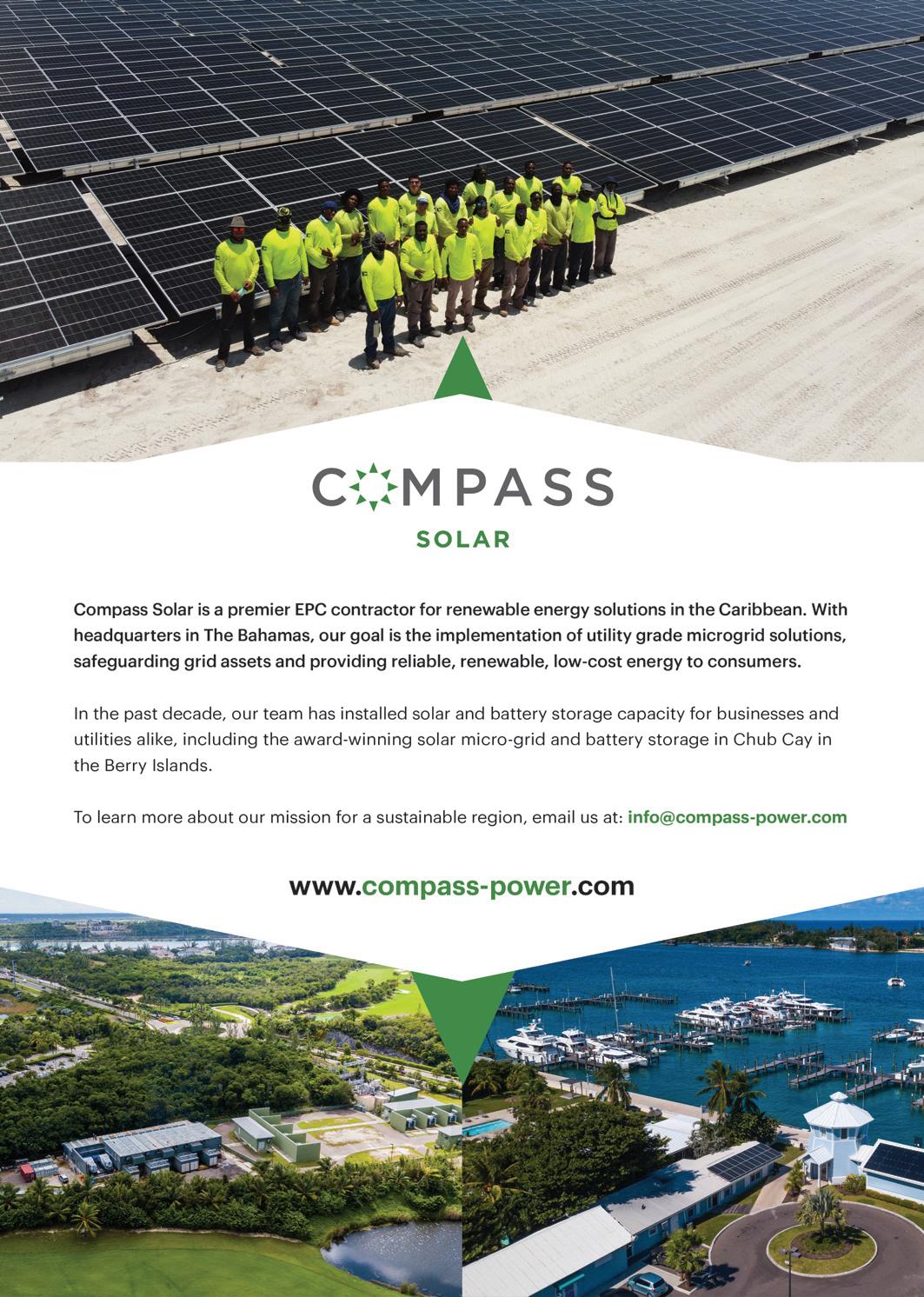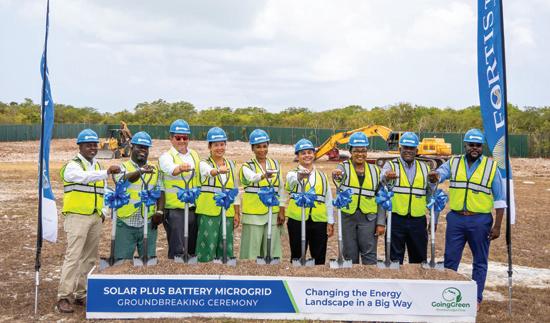




FORTISTCI
GREEN, ONE ISLAND
A TIME powered by Inside Sustainability inside-SUSTAINABILITY.com
GOING
AT
FortisTCI provides electricity throughout the Turks and Caicos Islands. Serving over 17,000 customers, it is regarded as one of the most reliable electricity providers in the Caribbean. Rachell Roullet, Vice President for Innovation, Technology and Strategic Planning, explained to Hannah Barnett how the company is transforming the energy landscape of the Turks and Caicos.
Since 2015, FortisTCI has been working out the best methods to seize the massive solar energy potential in the Caribbean, with significant success.
In 2018, the Caribbean Renewable Energy Forum voted the FortisTCI Utility Owned Renewable Energy system (UORE) as the ‘Best Distributed Generation Project’ in the region. This was a milestone for the company and a proud moment for its staff. FortisTCI has methodically improved its capabilities ever since. Though the company has been pursuing solar energy, it is also researching other renewables for its network, such as wind power and lower-carbon energy sources like natural gas.
FortisTCI operates in Providenciales, North Caicos, Middle Caicos, South Caicos, East Caicos and the adjacent Cays. The company also serves the islands of Grand Turk and Salt Cay. “The distinctiveness of our company is that we serve several islands,” explained, Vice President for Innovation, Technology and Strategic Planning Rachell

Roullet. “When it comes to sustainability, we take it one island at a time, to ascertain what is best for each island.”
Renewable innovations
FortisTCI offers two service options for customers wishing to switch to solar power. The first is for customers who wish to install their own solar PVs. The company provides incentives via its Customer Owned Renewable Energy credit (CORE).
The second option is the Utility Owned Renewable Energy (UORE) programme, which means the company installs the solar panels and offers a fixed-rate incentive based on capacity. FortisTCI has so far provided 2.6MW via 18 rooftop solar systems for 16 partners under its UORE programme, and has a long waiting list. The goal is to increase solar power capacity to 7MW in the short to medium term across the islands.
Though the Caribbean climate makes the Turks and Caicos an ideal location for
282 Inside sustainability
FORTISTCI I PROFILE
solar power, it is also vulnerable to other types of weather namely, hurricanes. 2017 was a particularly difficult year with three powerful hurricanes, Harvey, Irma and Maria wreaking huge damage to utility systems in the USA and the Caribbean.. Nonetheless, FortisTCI restored electricity service in less than 60 days, before the start of the tourist season.
“We live in a hurricane belt, so that always informs our actions,” Ms Roullet said. “It means we continue to invest in a hardened transmission and distribu -
tion network, as these hurricanes become more forceful – and perhaps even more frequent. Along with sustainability and affordability considerations, we also must ensure that our investments support resilience.”
The company consistently maintains a very high ASAI (Average Service Availability Index) of 99.96%, one of the highest in the Caribbean. This outstanding reliability helps to support the tourism-based economy and attracts direct foreign investment into the country.

Inside sustainability 283


FORTISTCI I PROFILE
And continuing innovation at the start of 2018, just months after the hurricane damage FortisTCI launched an e-mobility programme; showcasing its first electric vehicle charging unit on the island. “We are demonstrating how the utility will support the infrastructure of e-mobility,” said Ms Roullet. “We have ten EV charging units installed now; some on our premises and others with partners like local hotels.”
Regulatory reform
FortisTCI maintains active engagement with the government, to discuss the energy industry and regulatory reform of the sector. With a new Commissioner of Energy and Utilities in place, the company is even more focused on achieving regulatory reform.


“The existing electricity ordinance was drafted in 1980s: it needs to catch up with what's happening in the industry,” Ms Roullet explained. “We want a high penetration of renewable energy, but achieved in an orderly and equitable manner, respecting the regulatory compact and balancing safe, reliable,
least-cost and sustainable electricity service for TCI.”
FortisTCI drafted its Clean Energy Plan in 2021, guided by the Resilient National Energy Transition Strategy (integrated resource plan, or IRP), which was developed with and approved by the government in 2019. The IRP analyses long-term demand for electricity, alongside the long-term supply, and assesses the optimal mix of energy to meet these requirements. Based on the IRP, the optimal energy mix for Turks and Caicos is 33% renewable energy by 2040.
“We intend to see a greater penetration of RE by the time the study renews,” said Ms Roullet. “So, using these plans as our guiding principles, we are working towards greater renewable energy penetration as well as investing in research and development for sustainable projects.”
FortisTCI’s cleaner energy goals are also guided by the sustainability ambitions of its parent company, Fortis Inc, a leader in the North American regulated gas and utility industry. Fortis Inc has committed to a 2050 net zero direct GHG emissions target.

286 Inside sustainability
Roadmap to the future
Another innovative element to FortisTCI’s expanding renewables programme is the microgrid system currently being installed on two islands. These microgrids integrate utility-owned solar PV systems and thermal generators, together with a battery energy storage system (BESS) with stabilisation technology, to facilitate a seamless transition between grid-connected and islanded mode without any disruption to the electricity service to customers in the specified service territories.
“We are going green, one island at a time,” Ms Roullet explained. “North Caicos will be the first installation site; it is set to be powered by 30 per cent renewable energy We're going to install a 1.2MW solar PV with a 1MW battery energy storage system.”
This will mean North Caicos running on three sources of energy: the grid, the solar PV battery and the standby generator, providing a resilient energy package for the island. Salt Cay is also targeted to be 91% renewable energy powered by the end of 2024, with the installation of a 200kW solar PV and a 200kW battery energy storage system.
FortisTCI President and CEO Ruth Forbes stated: "We are taking significant steps to transform how we produce and distribute energy in the Turks and Caicos Islands. FortisTCI is greening the islands with our microgrid and other alternative energy projects.
“Microgrids on North Caicos and Salt Cay will decrease the overall cost of energy production in these islands. With appropriate amendments to the electricity

Inside sustainability 287



288 Inside sustainability
ordinance, customers can benefit from lower energy prices over time.
“We will continue to work with the Turks and Caicos Islands Government to achieve this outcome. Reducing our dependence on imported diesel fuel, expanding renewable energy integration, and lowering the cost ‘of electricity are all part of the sustainable energy future we are building for the Turks and Caicos Islands."


As a dynamic and evolving company, FortisTCI will play a key role in the energy transition process in Turks and Caicos.

According to Ms Roullet, working in the
centre of such progress is an exciting place to be.
“We’re not only changing the energy sources, but we are also changing the skills of the organisation,” she concluded. “We must learn to integrate the battery energy storage system, how to optimise solar PV systems and what role wind can play. We must diversify. Navigating this changing landscape of decarbonisation, decentralisation and digitalisation is the most exciting challenge in the utility industry.” n
Inside sustainability 289






















